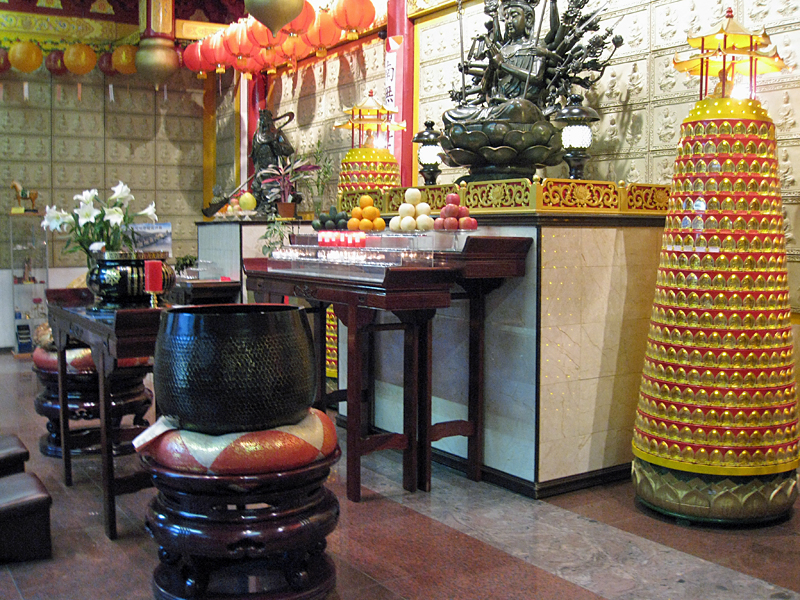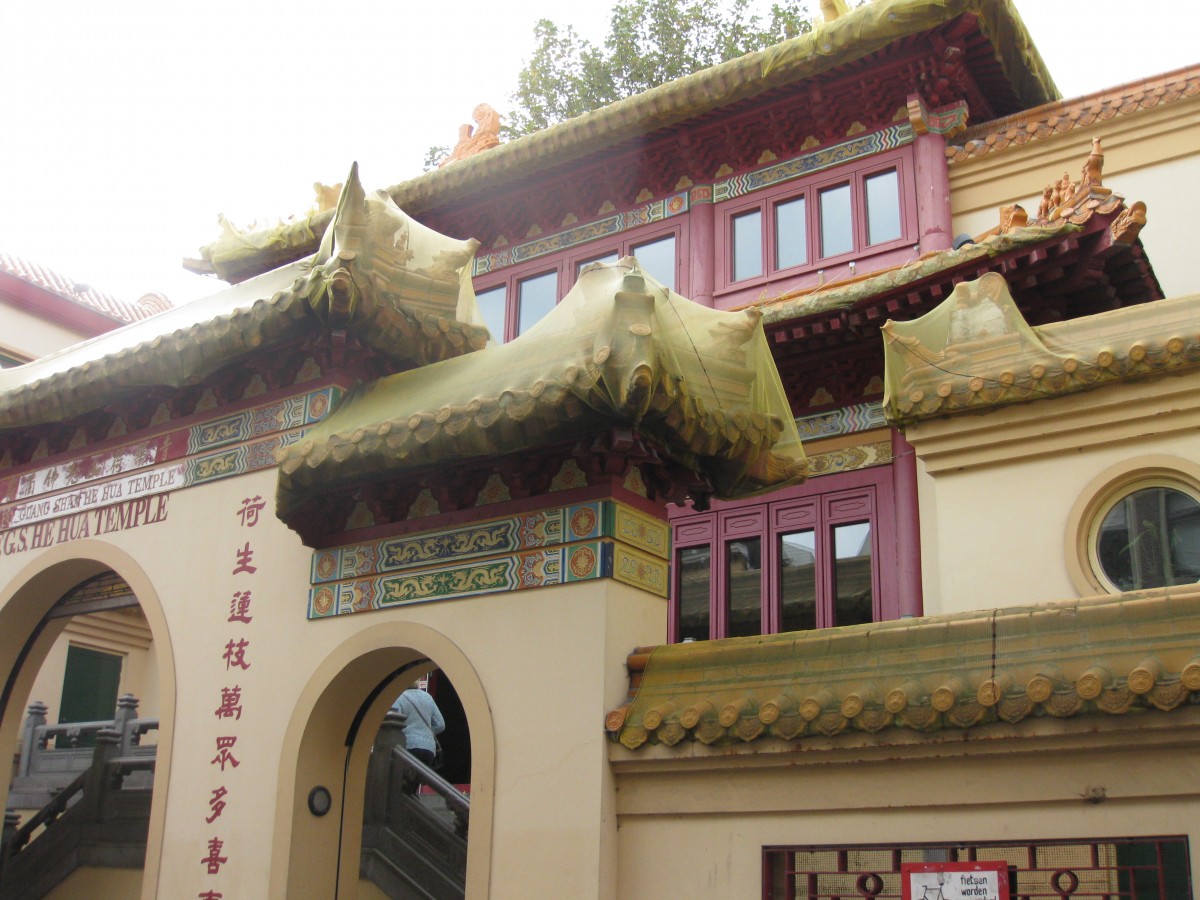Buddhist Temple in Amsterdam
The Fo Guang Shan He Hwa Temple in Amsterdam Chinatown is the largest Buddhist temple in Europe and built in traditional Chinese style. This Buddhist Temple is locally known as the Zeedijk Tempel. Zeedijk is the name of the street where you can find this temple. The temple’s main activity is religious. Still, the temple also fulfills a cultural function for the Chinese community in Amsterdam and welcomes visitors.

Guan Yin
The smell of incense wafts towards visitors. A shining statue of Guan Yin sits on an altar flanked by smaller statues of other Chinese deities. A row of candles burns on a low shelf in front of the shrine. Two pagodas with illuminated niches containing hundreds of miniature Buddha statues stand next to Guan Yin. The repetition of the images symbolizes Buddha’s omnipresence. Plaques with reliefs of Guan Yin and the names of the donors who enabled the construction of the temple cover the walls.

On a Hill Top
Buddhist temples and monasteries are traditionally built on the top of hills or mountains. The entrance to Fo Guang Shan He Hua Temple is through the three-arched Mountain Gate, but because there are no mountains in the Netherlands, a wide staircase leads to the Great Hall. Each step symbolizes practicing Buddhism. This gradual approach leads to bodhi – enlightenment or awakening. Enlightenment in the Buddhist sense has nothing to do with knowledge or intellect. It is an awakening to full realisation of the truth of the Buddha’s teachings.

No Heavenly Kings to Greet the Visitor
Since Fo Guang Shan He Hua Temple was built in the traditional Chinese style, four statues of the Heavenly Kings will greet visitors at the entrance. The kings, who lead armies of supernatural creatures, keep demons at bay. Wei Tuo, clad in full armour and holding a scepter-shaped weapon, stood guard at the back wall in the Great Hall, ready to fight off the demons bent on impugning the Faith and stealing the Book of Wisdom. Quite diappointingly, no Heavenly Kings to greet the visitor to the temple in Amsterdam.

Holy Shrine
The main shrine in the Great Hall is dedicated to Kuan Yin, a sage and seer. She is a bodhisattva, a divine being who attained enlightenment and helps others to salvation. She is said to have one thousand hands. These multiple hands symbolize her power to save all living beings. In her hands, she holds symbolic attributes – a Buddha statue on her upward turned hand palm, a vase pouring out water, just as Guan Yin pours out compassion, and a bell whose ebbing sound symbolizes wisdom. Seemingly entangled in Guan Yin’s hair is a tiny statue of Amitabha, the Buddha of the Pure Land. This is the land where the toils and worries of everyday life do not interfere with the teachings of Buddha.

Nirvana
In Buddhism as practiced in India people believe that life on earth is full of suffering and an endless circle in which people are born, grow old and die only to be born again in other bodies. The way to break out of this circle is by attaining personal enlightenment – nirvana. This individualistic approach does not appeal to Chinese collectivism. The Chinese strand of Buddhism, the Mahayana School, teaches that perfection for the individual is only possible with perfection for all. Those who attain perfection become known as bodhisattvas.

Reflection
Slip a euro or more in the donation box. The money will buy you a shiny red apple, not to eat but for an offering. Place the apple on the altar in front of Guan Yin’s shrine. Fruit is nutritious and has a pleasant taste. As an offering, it symbolises the result of spiritual cultivation. Likewise, an offering of flowers can be made – beautiful and fragrant but not lasting forever, they symbolize transience. Finally, light an incense stick, and take a moment of quiet reflection before descending the stairs and mingling with the crowd on Zeedijk.
Guided Tour
A guided tour is an opportunity to see more parts of the temple and get some insight in what Buddhism is about.
The one-hour guided tours are on appointment only and are held during the opening hours of the temple i.e. on Tuesdays, Thursdays and Saturdays. The guided tour is an introduction to Buddhism and explains the meaning of the symbols in the temple.
Download the application form at leat two weeks before your planned visit from the website of the He Hua Temple.
Address: Fo Guang Shan He Hua Temple, Zeedijk 106 – 118, Amsterdam
Opening hours: Tuesday, Thursday and Saterday from 13.00 – 15.00
The Temple, open to everyone and free of charge, is part of the International Buddhist Progress Society, I.B.P.C. founded by Hsing Yun, a Buddhist monk. The mother temple, Fo Guang Shan is in Taiwan.
Photos Marianne Crone
Next article: A Canal House for a Rich Merchant
Previous article: Museum Quarter and the Big Three



